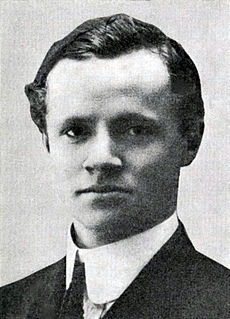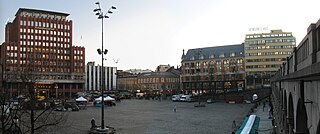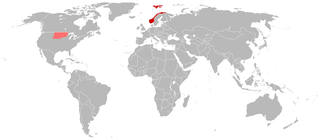
The Solidaires or Solidaires Unitaires Démocratiques (SUD) is a French group of trade unions.

The Fafo Research Foundation, also known as the Fafo Foundation or just Fafo, is a Norwegian research foundation, owning a research institute: The Fafo Institute for Labour and Social Research. The institute conducts social research both in Norway and internationally. Fafo has offices in Oslo and Beijing.
Catholic Church and politics aims to cover subjects of where the Catholic Church and politics share common ground.

The Bharatiya Mazdoor Sangh is one of the trade union organization in India. It was founded by Dattopant Thengadi on 23 July 1955.

The Sydney Trades Hall is a heritage-listed trade union building located at 4-10 Goulburn Street in the Sydney central business district, in the City of Sydney local government area of New South Wales, Australia. It was designed by John Smedley, with later additions Spain and Cosh and Minnett and built from 1888 to 1916. It is also known as Trades Hall Building. The building was built and owned by the Trades Hall Association, the original trade union affiliates who built the hall in 1888, and is now owned by Unions NSW. The property was added to the New South Wales State Heritage Register on 2 April 1999.

Halvdan Koht was a Norwegian historian and politician representing the Labour Party.
People's Houses were originally leisure and cultural centres built with the intention of making art and cultural appreciation available to the working classes. The first establishment of this type appeared in Tomsk, Russian Empire in 1882. Soon people's Houses became popular in England, Scotland, Turkey and other European states.

Olav Hindahl was a Norwegian trade unionist and politician for the Labour Party.

Alfred Martin Madsen was a Norwegian engineer, newspaper editor, trade unionist and politician for the Norwegian Labour Party. He began as deputy chairman of their youth wing, while also working as an engineer. In the 1910s he rose in the hierarchy of the party press, and eventually in the Labour Party and the Confederation of Trade Unions as well. He was an important party and trade union strategist in the 1920s. He served six terms in the Norwegian Parliament, and was the parliamentary leader of his party for many years. He was twice a member of the national cabinet, as Minister of Social Affairs in 1928 and Minister of Trade from 1935 to 1939.
Amedia AS is the second largest media companies in Norway. The company is whole or partial owner of 50 local and regional newspaper with online newspapers and printing presses, and its own news agency, Avisenes Nyhetsbyrå. The corporation also owns and operates a group of printing plants under the brand name Prime Print in Russia.

The Working Class Movement Library (WCML) is a collection of English language books, periodicals, pamphlets, archives and artefacts relating to the development of the political and cultural institutions of the working class which were created by the Industrial Revolution. It is situated in Salford, Greater Manchester, England.

Youngstorget is a square and public space located in downtown Oslo. It lies at the junction of the streets Storgata and Møllergata and alongside Torggata. Constructed in 1846, it has become a symbol of political power in Norway.
Framfylkingen is the children's and families' organisation of the Norwegian Confederation of Trade Unions, the activities of which include popular education and socialist education. Earlier it was closely associated also with the Norwegian Labour Party.

Konrad Mathias Nordahl was a Norwegian trade unionist and politician for the Labour Party. He was the leader of the Norwegian Confederation of Trade Unions from 1939 to 1965, and an MP from 1958 to 1965.
Fagopposisjonen av 1940 was a grouping among Norwegian trade unionists in 1940, after the German invasion of Norway.
Arbeidernes Esperantoforbund was an association in the Norwegian labour movement that worked for the introduction of the Esperanto language.
Arbeiderklassens Samlingsparti was a short-lived political party in Norway.

Sverre Johan Iversen was Norwegian trade unionist, civil servant and politician for the Labour and Social Democratic Labour parties.
The labour movement or labor movement consists of two main wings, the trade union movement or labor union movement, also called trade unionism or labor unionism on the one hand, and the political labour movement on the other.

















